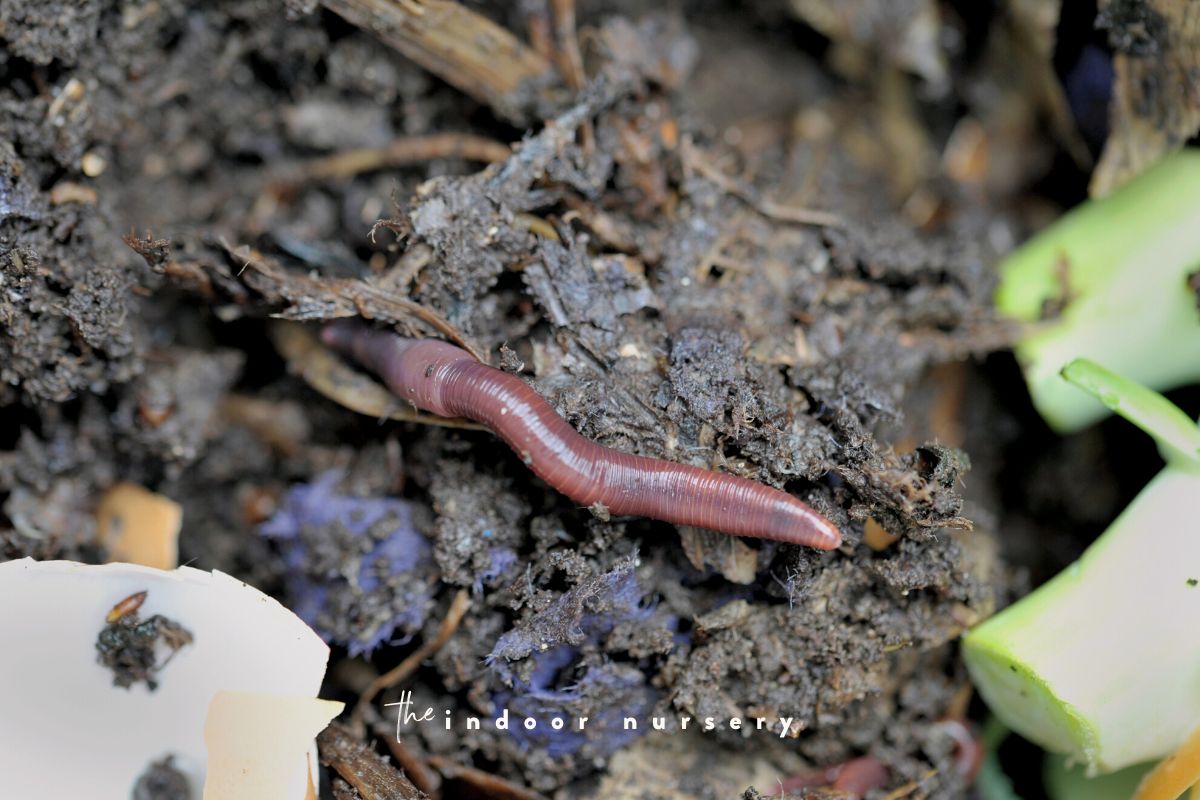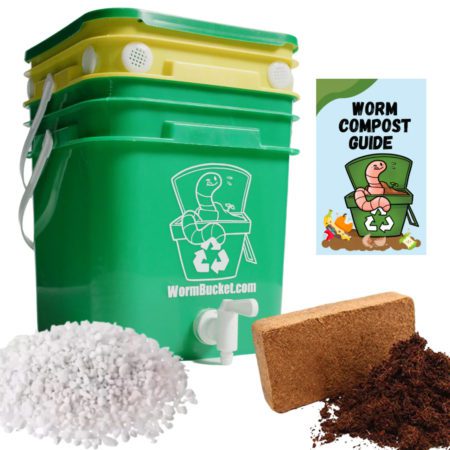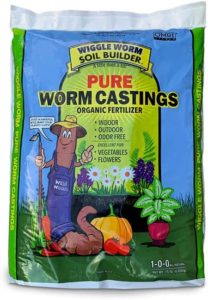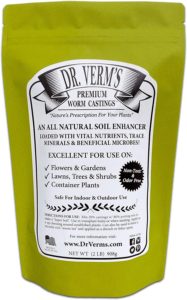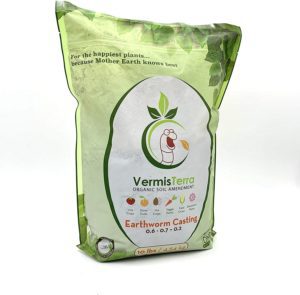Worms are one of the major players in soil ecosystems: not only do they aerate the soil as they move through it, they help make the soil by digesting the organic material found in the ground.
We can harness that productivity by keeping worms in a home compost bins for homemade worm castings, or by companies with a worm farm that produce worm-castings we can buy in stores.
Castings help build soil, hold moisture, and provide essential nutrients to support good plant growth and keep them in their happiest and healthiest condition.
What are worm castings?
Worm castings are worm manure, collected to be used as fertilizer for all kinds of growing applications. They are particularly useful for potted plants because the soil isn’t naturally turned over and refreshed the way it is in the ground (and we wouldn’t want to try to support a whole soil ecosystem inside of our homes anyway!) Plant parents have to replenish the nutrients in the pots every once in a while because plants absorb and use up the soil’s nutrients over time.
When worms digest organic matter, whether it’s in the ground or in your compost bin, they provide a second layer of decomposition in addition to bacteria and fungus that makes nutrients from the material even more easily available to plants, as well as adding some of their own microbiome’s organisms and nutrients. Worm castings are full of essential nutrients, microbes, and beneficial bacterial that nourishes plants and help them remain healthy, strong, and in their best-looking condition.
You can easily “farm” your own worms and get fresh worm castings right at home with a worm compost bin like this:
What do worm castings look like?
Knowing how to spot good worm castings is a good gardening skill that is helpful whether you have a worm composting bin at home or you’re purchasing a retail product. High quality worm castings are dark brown, almost black, with the consistency of coffee grounds. It’s crumbly, while retaining some moisture in its material. There shouldn’t be any identifiable materials in it; it should really just look like dirt! While worm castings are generally odorless, but if they do have a scent, worm castings smell of moist earth (and they shouldn’t smell like anything else).
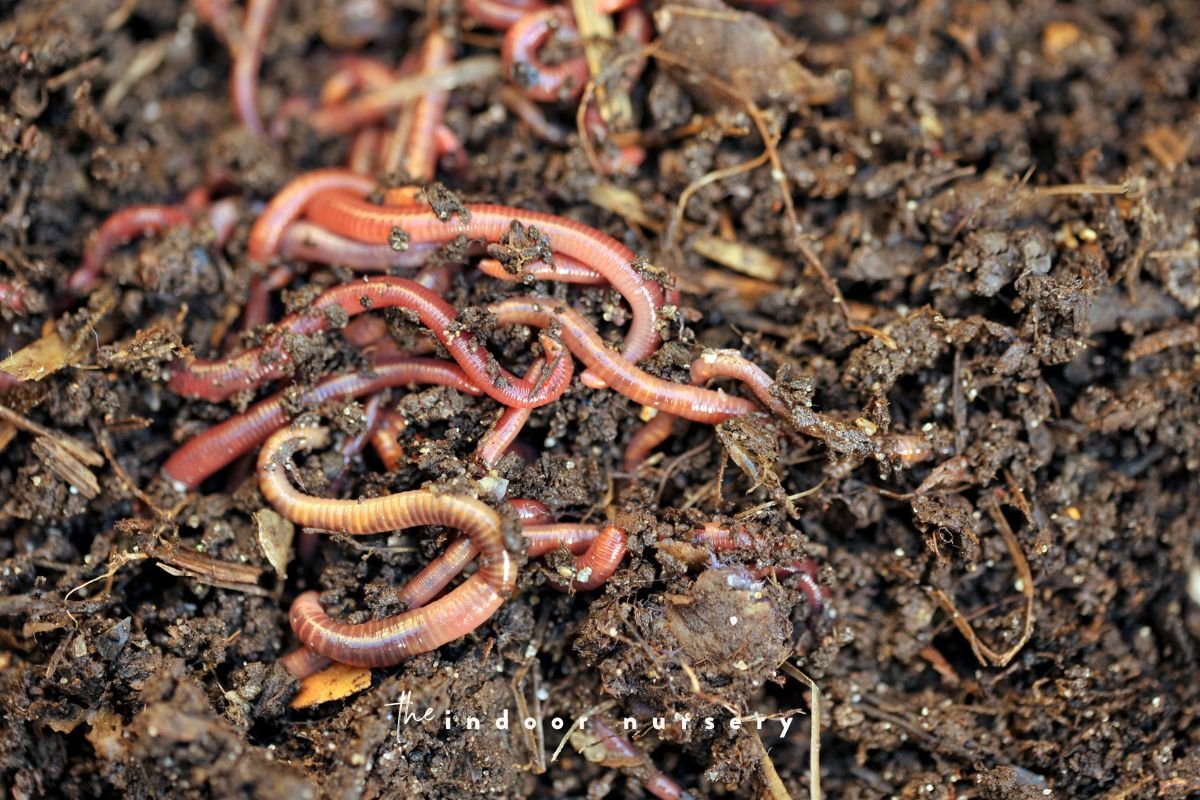
Benefits for plants and soil
Worm castings contribute a range of benefits when they’re used to keep your plants happy and healthy:
- Essential nutrients – Worm castings have many of the essential nutrients plants need to survive, including nitrogen, phosphorus, and potassium, as well as copper, magnesium, and calcium, among many others.
- Beneficial bacteria and microbes – When worms eat organic material, they take in some microbes that eventually pass through the worm and remain in the castings. Casings will also include microbial life from the worm’s digestive tract, which further increases the biotic activity of the soil.
- Humic acid – A result of the decomposition process, humic acids are found in organic matter, and as they’re released, they aid in making nutrients available and easily absorbed.
- Slow-release fertilizer – Since worm castings are organic material, they break down slowly over time and stay in the soil until they are used by the plants at their own pace.
- Neutral pH – Worm castings have a pH level of 7, neutral, which means it will help soil from becoming either too acidic or too alkaline. Be sure to monitor your soil’s pH level when you add any kind of fertilizer so that it doesn’t go out of your plant’s preferred range!
- Adds bulk to soil – Since worm castings are solid, organic material, they contribute to the soil structure that holds moisture and air, in addition to contributing a supply of nutrients.
Where and how to use worm castings
Seeds, seedlings, young plants, and mature specimens all benefit from worm castings, but plants will use them a little differently in each stage of life.
Vegetable plants & annual flowers
Vegetables and fruits are grown to be harvested each year, and many of them are annual plants. Annual plants, like flowers and some food plants, grow anew each year by producing seeds that are meant to sprout in the following warm season (in contrast to perennial plants, which grow for several years by establishing robust root systems). The readily available and steady supply of nutrients from worm castings allows plants to grow fast, strong, and have enough energy to produce lots of flowers, fruits, and/or vegetables before they die at the end of the growing season.
Indoor plants
The amount of worm castings any particular indoor plant likes can be estimated by its natural habitat. Plants that come from places with nutrient-dense soil, like rainforests, tend to like a little more fertilizer than plants that come from places with very low amounts of soil, like deserts. Monsteras and philodendrons, for example, like to be fertilized once a month, or given a more frequent, but diluted, supply by adding worm castings to water. A succulent or cactus, on the other hand, might like a small amount of worm castings only once or twice a year.
Seeds & seedlings
Seeds and seedlings benefit greatly from the nutrient-rich, moisture-retaining nature of worm castings. Seeds and seedlings grow at rapid rates, absorbing moisture and nutrients round-the-clock as they sprout to grow their stems and leaves. The soft and fluffy nature of worm castings also provides a porous environment for seeds and new plants to grow their roots, which will stretch around and absorb as many nutrients they can to develop into mature specimens.
Worm casting tea
Even though worm castings make nutrients easily available to plant roots, they are a solid, slow-release type of fertilizer. However, mixing castings with water allows you to apply a liquid form to your plants full of nutrients that they can soak up right away. The tea is made with a mixture of water, worm castings, and molasses that sits for a day to brew. During that time, beneficial bacteria proliferate and further digest nutrients and release them for your plants to absorb. The microbiotic life also contributes to the soil’s ecosystem, resulting in a healthy and active growing environment for your potted plant.
Here’s a link to our worm tea recipe that you can easily make at home!
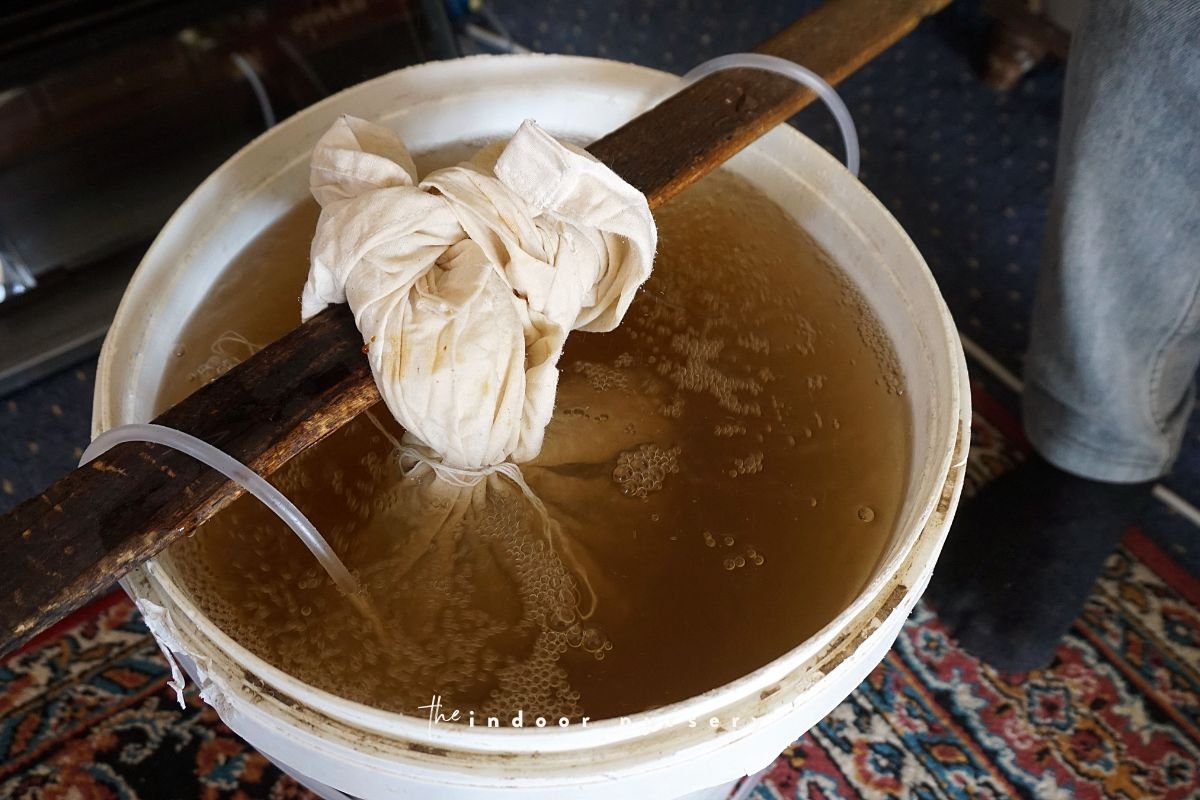
Common questions
Like any fertilizer, there are best practices on how to apply worm castings. Here, we’ll go over some of the most common concerns.
How much worm castings do I use?
The amount of worm castings right for any plant may differ a bit based on how big the plant is and the size of the pot, as well as what type of plant is receiving the castings. If you purchase worm castings, the product’s label should have application instructions on quantity. In the case of larger plants, a cup or two of worm castings should be sufficient, while small to medium pots can be replenished with about a half inch thick layer of castings on the soil surface. Be sure to mix the castings into the surface of the potting soil to incorporate it more evenly and help the nutrients reach the roots more quickly.
How often should you use worm castings?
Worm castings break down over several months, so it’s generally recommended to apply a serving once a season, with half-applications (if any) during the colder periods of the year. If you heavily dilute the castings in water, it can be given to plants that like a regular supply of nutrients every two weeks. Be sure to monitor the soil’s pH level if you decide to do this, since the neutralizing effect of worm castings might affect your plant’s comfort level (in fact, many of the rainforest houseplants plants that like a regular supply of fertilizer prefer slightly acidic soils).
How long do worm castings last in the soil?
When you apply a serving of worm castings to your plant’s soil as a solid fertilizer, they last between 2 to 3 months (or for a season). The material is already digested and ready to be leached by your plant, but as an organic material, the nutrients won’t all be released at once. When you use a diluted form in water or a worm castings tea, the nutrients in the liquids won’t last in the soil nearly as long as solid forms, but more of the nutrients will be absorbed at once.
Can worm castings cause nutrient burn?
Worm castings are organic material that won’t shock your plants with an abundance of nutrients. Too much of anything, however, can be harmful, if not from nutrient burn: the density of worm castings may overwhelm the roots of mature plants if too much is used, from holding too much moisture, or compacting and holding too little oxygen. It can also neutralize the pH to an uncomfortable level for certain plants. Seeds, on the other hand, are happy to grow in an abundance of soft, moist, nutrient-dense, worm castings!
What is the ratio of worm castings to soil?
Mature plants need soil that drains well and contains coarse material like perlite, sand, clay, or gravel to help the moisture flow down and out of the pot. Soilless growing mediums (lacking any inorganic material) may use a simple mixture of worm castings and coco coir. In any case, a mixture of 20-33% worm castings, or 1 part worm castings to 2 to 4 parts coco coir and/or coarse soil materials (depending on your plant’s soil preference), will keep the growing environment from becoming too much of a neutral pH if your plant doesn’t like it to be.
Can I use worm castings as my regular fertilizer?
The neutral pH (7) of worm castings makes it unable to completely replace fertilizer, since many houseplants like a slightly acidic, or slightly alkaline, soil environment (although some do like a neutral pH). Be sure of the preferred pH level of the plants you’re growing and use a pH test before applying any kind of fertilizer. If the pH level of the soil is off balance for a particular plant, certain nutrients become inaccessible to that plant, which can take a toll on its health.
Where to buy worm castings
You can buy worm castings at a variety of locations, including nurseries and garden stores, home repair stores, and online. Here are some of our top choices available on Amazon:
Wiggle Worm – Wiggle Worm Soil Builder is a very popular organic worm casting fertilizer, with lots of positive reviews from its large customer base. This company underlines the pureness of their product, emphasizing their adherence to a particular production system that ensures the highest quality worm castings.
Dr. Verm’s Premium Worm Castings – Dr. Verm’s pays close attention to their production process as well, making sure their worms are well-fed and taken care of at each harvest and throughout their lifetime. Their product is free of chemicals and additives, resulting in natural and organic worm castings.
VermisTerra – VermisTerra Earthworm Castings are another great choice for retail worm castings. Their organic product builds your soil and improves plant health and productivity from the nutrient-dense castings, which are aged for 7 to 10 years for the most efficient plant uptake.
more about composting
- 10 Best Worm Composter Bins For Easy Homemade Compost
- Compost Starter 101: When You Need It And How To Make It
- How to make a DIY indoor worm composting bin in 4 steps
- What to do with extra scoby (hint: it’s good for the soil)
- Vermicomposting for beginners: how to compost indoors for happy plants
- How to use worm castings for happy plants
- How to make worm casting tea in 4 easy steps
- Here’s how to harvest worm castings
- how to use compost accelerator for faster composting
- how long does compost take to turn into nutritious soil? it depends

